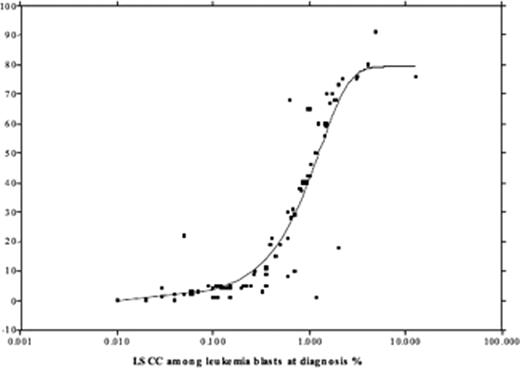Abstract
Abstract 2160
We have shown that leukemia stem cells candidates (LSCC) can be prospectively identified by high activity of aldehyde dehydrogenase (ALDHbr) and expression of CD34 among the leukemia blasts from the marrow of patients with AML. In this study we have examined the relationship between the frequency of LSCC at diagnosis with persistence of leukemia blasts after induction chemotherapy as well as with long-term clinical outcome. Using single cell sorting, we have further separated subsets among the LSCC and correlated their individual functional properties with the respective marker constellation. The percentage of LSCC in 101 patients ranged from 0.01% to 12.90% with a median of 0.51%. Frequencies of LSCC among the leukemia
blasts at diagnosis correlated significantly with the persistence of leukemia after the first induction chemotherapy (n=79, Spearman R=0.7797, P<0.0001). During the observation period of 24 months, 21 of 60 patients with high levels of LSCC died as compared to 7 of 41 patients with low levels of LSCC (p=0.029). The overall survival (OS) probability for the patients with high levels of LSCC was significantly worse (p=0.05) than in those with low LSCC. Characterization of these LSCC at a single cell level showed that a varying proportion, i.e. 15% to 78% of their progeny cells demonstrated the same chromosomal aberrations as the original leukemia population, indicating the presence of residual normal HSC. Thus high frequencies of LSCC at the time of diagnosis predict persistence of leukemia blasts, failure to achieve CR within the first cycle and poor overall clinical outcome. Our prospective separation of LSCC permits precise characterization of the biological properties of the subsets of stem cell candidates in human AML.
Ho: Genzyme: Membership on an entity's Board of Directors or advisory committees, Speakers Bureau; Roche: Membership on an entity's Board of Directors or advisory committees.
Author notes
Asterisk with author names denotes non-ASH members.


This feature is available to Subscribers Only
Sign In or Create an Account Close Modal